Butternut Squash Baby Food Puree
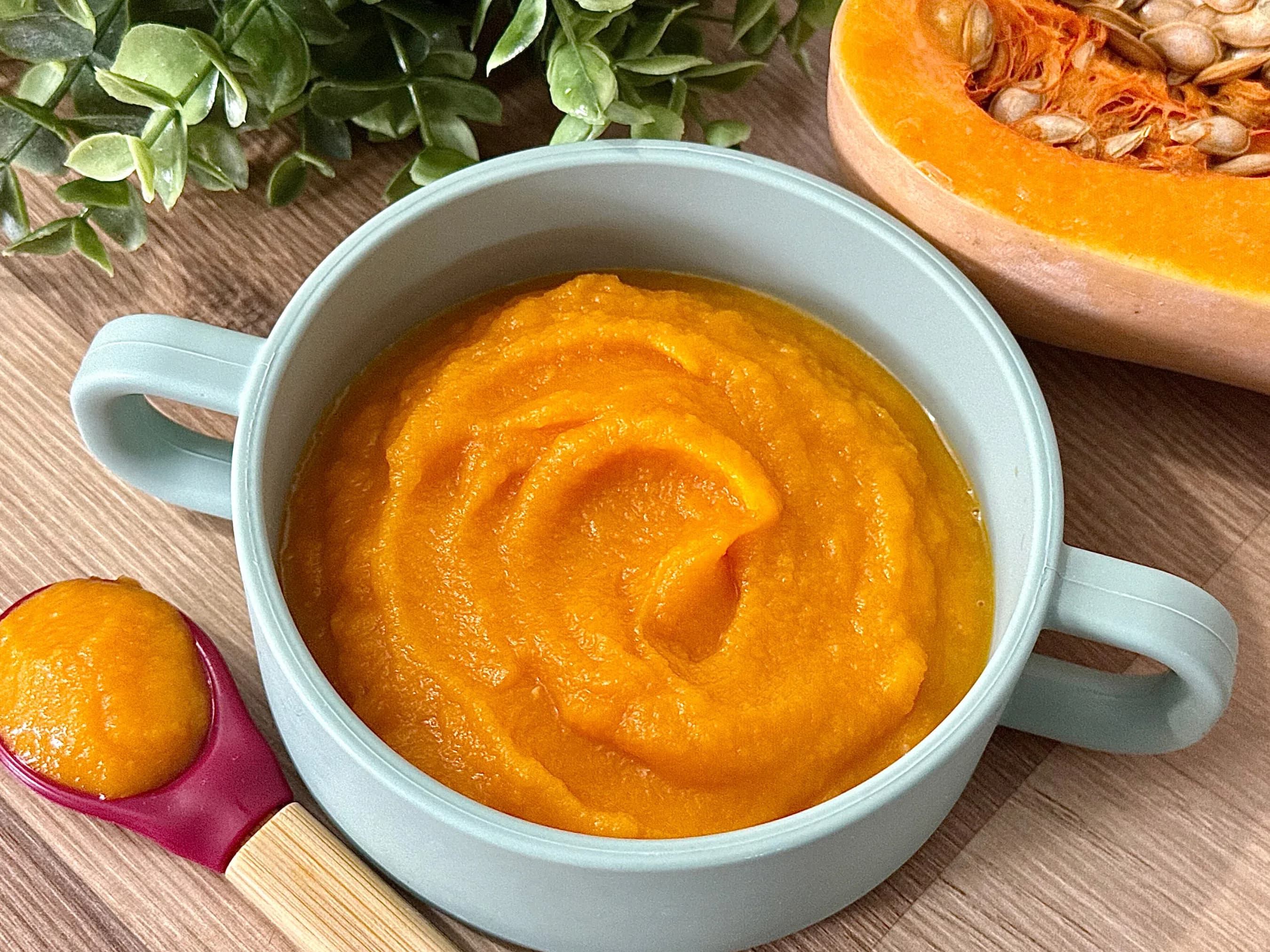
Written by Kenny Ekerin
Fact Checked by Mindsmaking Professionals
24th, November, 2025
This post may contain affiliate links. Please read our disclosure policy.
Looking for a simple and wholesome first food for your baby? Butternut squash is a great choice—it's packed with vitamins, has a naturally sweet flavor. Whether you're just starting solids or batch-prepping homemade baby food, this one’s a winner!
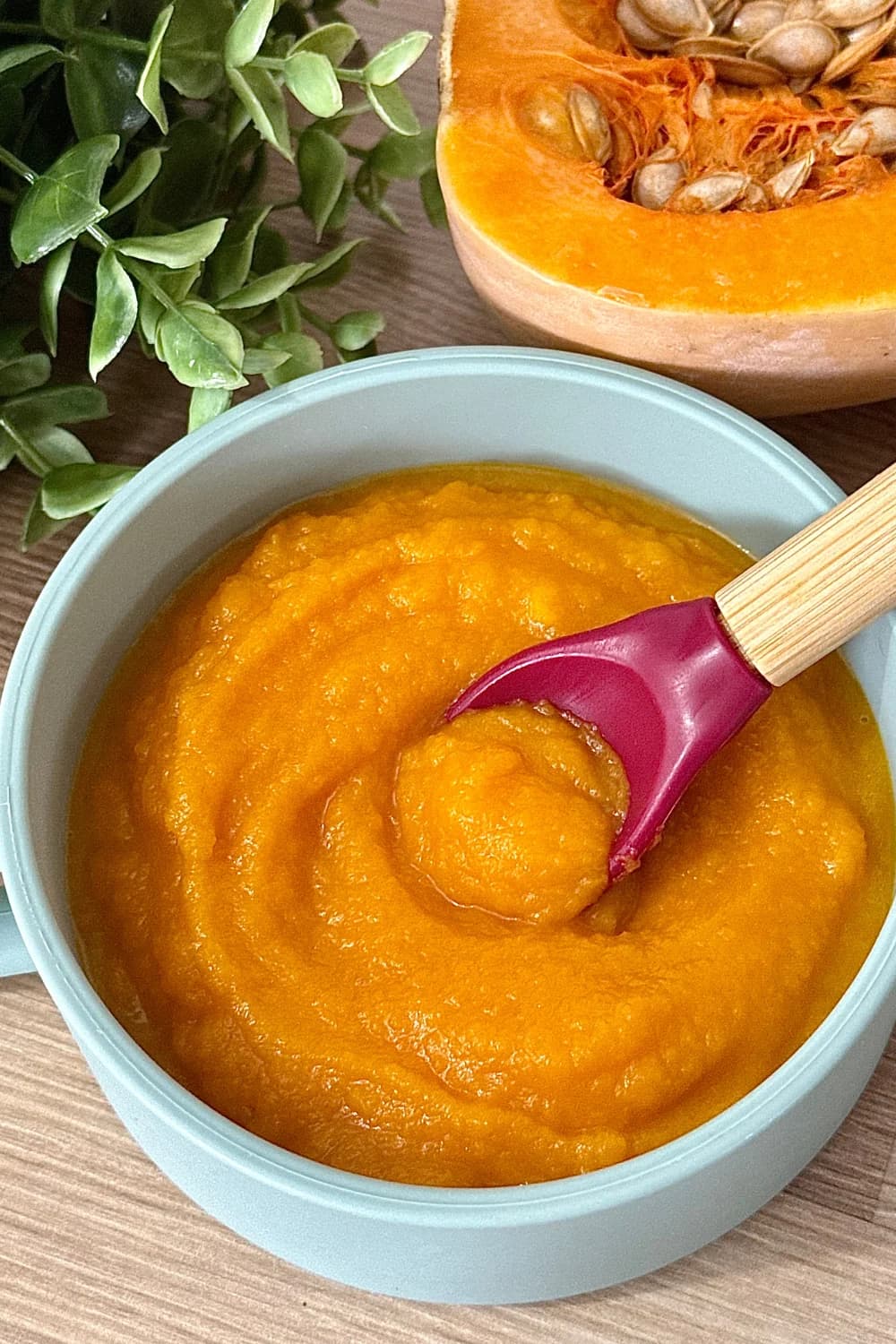
Why Butternut Squash is a Baby Food Favorite
A Naturally Sweet and Soothing First Food: One of the best things about butternut squash is its naturally sweet, mellow flavor. Babies are drawn to it right away, which makes it a gentle and comforting introduction to solids. It’s soft when cooked, easy to purée, and has a creamy texture that makes it perfect for spoon-feeding or mixing into other foods.
If you're just starting out with first foods for baby, butternut squash is an ideal choice to help make those first bites feel cozy and enjoyable.
Packed with Baby-Friendly Nutrition: Butternut squash isn’t just tasty—it’s also packed with essential nutrients that support healthy growth and development. It’s rich in vitamin A, which is great for your baby’s developing vision and immune system. It also offers vitamin C, fiber, potassium, and small amounts of iron and calcium.
These nutrients help support digestion, immunity, and early bone growth, making it a truly wholesome option for homemade baby food.
Easy to Cook and Versatile in Meals: Whether you roast it, steam it, or boil it, butternut squash is super easy to prepare. You can serve it smooth and simple as a purée for younger babies, or mash it with other ingredients for older ones exploring new textures. As your baby grows, you can mix it with grains like quinoa cereal or rice cereal, or stir it into pasta or lentils. It’s a wonderful veggie to grow with your child, from purees to finger foods and beyond.
Perfect for Batch Cooking and Freezing: Butternut squash is a dream for baby food meal prep. It yields a generous amount of purée, stores well in both the fridge and freezer, and reheats beautifully without losing its flavor or texture. Whether you're preparing a few servings for the week or stocking your freezer with nourishing cubes, this veggie makes your life easier while keeping baby well-fed.
How To Make Butternut Squash Puree
Ingredients
- 1 medium butternut squash
- 1–2 tsp olive oil (totally optional)
- Water, breast milk, or formula (just to thin it out if needed)
Mindsmaking

Step-by-Step Instructions
1. Get the Squash Ready: Start by giving the squash a good rinse. Then, using a sturdy knife, slice it in half lengthwise—careful, it can be tough! Scoop out the seeds and stringy bits with a spoon and set those aside (or roast the seeds for yourself!).
Mindsmaking
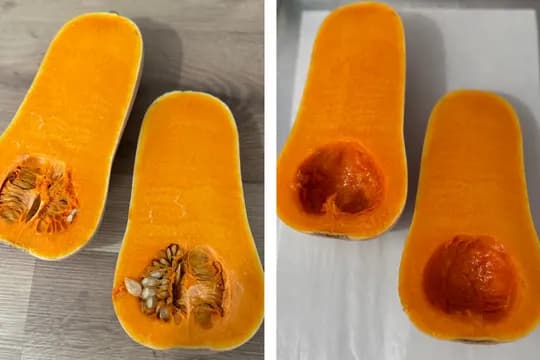
2. Roast It: Preheat your oven to 175 °C. Place the squash halves, cut side up, on a baking sheet. You can brush the squash with a little olive oil if you like, but it’s optional. Pop the tray in the oven and bake for 45 to 60 minutes, or until the squash is fork-tender and the flesh is soft.
Alternative Cooking Methods
- Steaming: Peel, cube, and steam the squash for 15–20 minutes until tender.
- Boiling: Peel, cube, and boil for 10–15 minutes, then drain well.
(Note: Baking preserves the sweet flavor and more nutrients.)
Mindsmaking

3. Blend It Up: Once the squash is cool enough to handle, scoop out the soft flesh and toss it into a blender or food processor. Blend until smooth and creamy, adding a little water, breast milk, or formula to achieve the perfect texture for your baby.
Mindsmaking
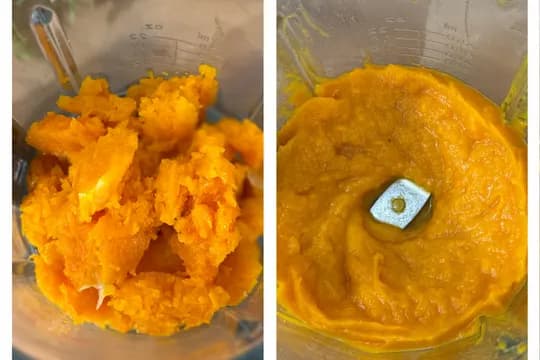
4. Serve or Store: Let the purée cool to a safe temperature for babies, then serve.
You can also store leftovers in an airtight container in the fridge for up to 3 days.
Read This Next

Recipe Ebook
Essential Guide to Starting Solids for Babies 6 Months+ - LBH Top 70 Baby Puree & Porridge Recipes eBook.
Start your baby’s solids journey with confidence using this "70 Baby Purees & Porridges" eBook! Created with care, this digital guide is packed with nutrient-rich recipes for babies 6 months and older, including purees and porridges tailored to each stage of your baby’s development.
Mindsmaking
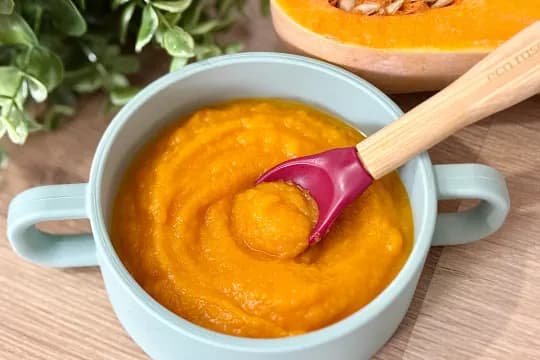
Tips For Success
1. Choose a Good Squash: Pick a butternut squash that feels heavy for its size and has a smooth, firm skin—no soft spots or cracks. A ripe squash yields the sweetest, creamiest purée.
2. Let the Oven Do the Work: Roasting the squash brings out a natural sweetness that babies love. Plus, it softens everything perfectly for blending—no need to peel before baking, which saves you time and effort.
3. Blend to Baby’s Stage: For babies just starting solids, keep the purée super smooth and runny by adding a bit of water, breast milk, or formula. For older babies (7–8 months), you can leave it a little thicker or mash instead of blending.
Serving suggestions
Start Simple for First Tastes: When your baby is just starting solids—usually around 6 months—serve the butternut squash purée on its own. Make sure it’s warm (not hot), and check the temperature with the inside of your wrist. The smooth, naturally sweet texture makes it a perfect first food for baby, especially for tiny tummies still adjusting to solids.
Mix and Match for Flavor Variety: Once your little one is comfortable with single-ingredient purees, you can start creating simple combinations. Butternut squash pairs beautifully with apple puree, pear puree, carrot puree, or sweet potato puree. These baby food combinations not only add flavor but also introduce new textures and nutrients, helping your baby expand their palate in a gentle, familiar way.
Serve with Finger Foods for Baby-Led Weaning: For older babies exploring baby-led weaning, try spreading the purée onto soft finger foods like strips of toast, cooked veggies, or slices of ripe avocado. You can also stir it into baby oatmeal cereal, quinoa cereal, or mashed lentils for a more filling meal. This is a great way to keep offering the flavors they love while encouraging independence at mealtime.
Let Baby Lead the Way: No matter how you serve it, remember that every baby eats at their own pace. Some may dive right in, while others need a few tries. And that’s okay! Mealtime is about more than just food—it’s about exploring textures, building confidence, and enjoying time together. Embrace the mess, follow your baby’s cues, and celebrate the little wins along the way.
How to Store
Short-Term Storage in the Fridge: Once your purée has cooled to room temperature, you can store any leftovers in an airtight container and keep them in the fridge. It will stay fresh for up to 3 days, which makes it perfect for prepping a few meals ahead. This is a great option if you’re serving your baby the purée over the next couple of days and want to keep things simple and fresh.
Freezing for Long-Term Convenience: If you’ve made a larger batch—or just want to have some on hand for those busy days—Spoon the cooled butternut squash purée into ice cube trays or silicone baby food molds to create perfect little portions. Once frozen solid, pop the cubes into a labeled, freezer-safe bag or container. They’ll stay good for up to 3 months, and it’s so handy just to grab a cube or two whenever you need them.
How to Thaw and Reheat: When you're ready to serve the purée, simply remove as many cubes as needed. You can thaw them in the fridge overnight, gently warm them on the stove, or microwave them in short intervals (stirring often). Always test the temperature before feeding to make sure it's just right—not too hot for baby’s sensitive mouth. If the purée thickens slightly after thawing, simply stir in a splash of water, breast milk, or formula to smooth it out.
Nutrition
Suitable for 6 months +
per serving, approximate)
- Calories: 180-220 (depends on milk and toppings)
- Protein: 5-7g (chia seeds and yogurt)
- Healthy Fats: 8-10g (chia seeds)
- Carbohydrates: 25-30g (fruit, milk)
- Fiber: 6-8g (chia seeds, fruit)
- Vitamin C: from apples and bananas
- Calcium: from milk and yogurt
- Iron: from chia seeds
- Omega-3s: from chia seeds
Note: Nutritional values are estimates and may vary based on ingredient brands and portion sizes.
Frequently Asked Questions
When can I start giving my baby butternut squash purée?
Butternut squash purée is a great first food for babies around 6 months old, when they’re ready to start solids.
How do I make butternut squash purée for babies?
To make butternut squash purée, cut the squash in half, scoop out the seeds, and roast it flesh-side down on a baking sheet. After baking for 45-50 minutes, scoop out the flesh and blend it until smooth.
Can I freeze butternut squash purée?
Yes! Butternut squash purée freezes wonderfully. Simply spoon the purée into ice cube trays or silicone molds, freeze, and store in a freezer-safe bag for up to 3 months. Just thaw and reheat as needed.
Can I add anything to the purée to enhance the flavor?
While butternut squash is naturally sweet and flavorful, you can mix it with other baby-friendly foods like apples, carrots, or sweet potatoes for added variety and nutrients. You can also add a pinch of cinnamon once your baby is ready for more flavors.
How can I store butternut squash purée?
Store leftover butternut squash purée in an airtight container in the fridge for up to 3 days. If you’ve made extra, freezing the purée in ice cube trays is a great way to have convenient, portioned servings ready.
Was this article helpful?
How many stars are you giving this article?
Leave a comment
Your email address will not be published.
Comments
More From Recipe

Chocolate Smoothie Chia Pudding
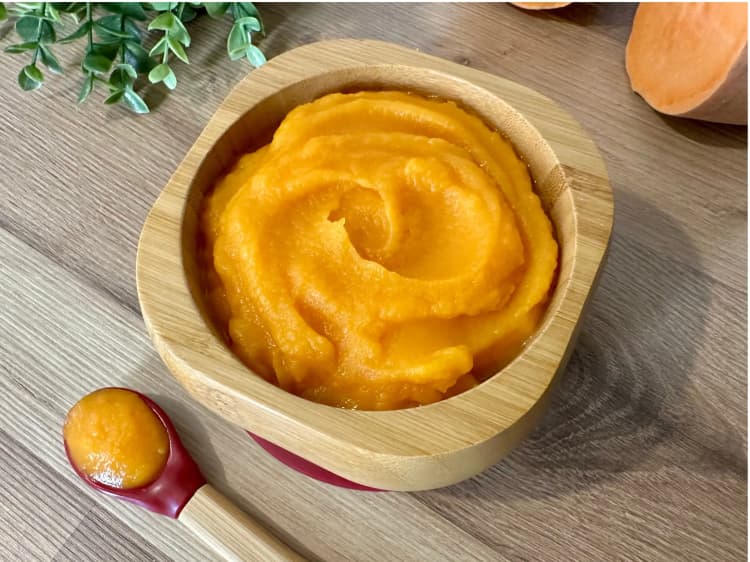
Sweet Potato Puree

Applesauce Pancakes

Sweet Potato Broccoli Fritters

Carrot Oat Pancakes

Easy Butternut Squash Muffins
Get new recipes to your inbox
Subscribe to our weekly newsletter and get new recipes sent to your inbox!